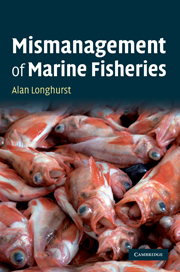Book contents
- Frontmatter
- Contents
- Preface
- 1 From certainty to doubt in fishery science
- 2 The ecological consequences of the exceptional fecundity of teleosts
- 3 Indeterminate growth, negative senescence and longevity
- 4 Marine ecosystems: their structure and simulation
- 5 The natural variability of fish populations and fisheries
- 6 Has sustainability in fishing ever been achieved?
- 7 What is the real state of global fish populations?
- 8 The mechanics of population collapse
- 9 Why don't some fish populations recover after depletion?
- 10 Is the response of the fishery science community appropriate?
- 11 Conclusion: sustainability can be achieved rarely and only under special conditions
- Index
9 - Why don't some fish populations recover after depletion?
Published online by Cambridge University Press: 05 July 2014
- Frontmatter
- Contents
- Preface
- 1 From certainty to doubt in fishery science
- 2 The ecological consequences of the exceptional fecundity of teleosts
- 3 Indeterminate growth, negative senescence and longevity
- 4 Marine ecosystems: their structure and simulation
- 5 The natural variability of fish populations and fisheries
- 6 Has sustainability in fishing ever been achieved?
- 7 What is the real state of global fish populations?
- 8 The mechanics of population collapse
- 9 Why don't some fish populations recover after depletion?
- 10 Is the response of the fishery science community appropriate?
- 11 Conclusion: sustainability can be achieved rarely and only under special conditions
- Index
Summary
‘I know the human being and fish can coexist peacefully.’
George W. Bush, Saginaw, Mich., 29.9.00Simple population models incorporating density-dependence suggest that a collapsed population should begin to recover when the fishing fleet turns to other, more rewarding areas, so that mortality on the depleted population is relaxed. Unfortunately, this is not a sure outcome. The uncertainty of recovery, and the reasons why some collapsed populations remain stubbornly collapsed, are the topics approached in this chapter.
As early as the end of the nineteenth century, Garstang had reported that populations of plaice in the southern North Sea were significantly reduced in abundance compared with earlier years, and larger fish were relatively less numerous; consequently, overfishing became both a catchword, and a worry. But the inadvertent great fishing experiments of 1914–18 and 1939–45 both produced clear evidence that a reduction in effort can indeed result in almost complete recovery of fished populations; post-war investigations in 1919, led by Graham, and in 1946 by a larger team, showed conclusively that 4–5 years of rest from fishing had permitted the plaice populations to recover their early abundance, as recorded in data on catch rates. The stock biomass increased by a factor of five during the first conflict and by a factor of three during the second, and the modal lengths of adult fish also increased by about 20 cm during each of these wars. These recoveries of plaice populations, and evidence from elsewhere in the North Sea, were discussed at the International Overfishing Conference of early 1946, very soon after the end of hostilities. These recoveries, after just a few years' relief from fishing, might encourage us today except for the fact that in neither of the pre-war periods was the plaice population in the southern North Sea as heavily depleted as many stocks are now. Today, of course, it would be difficult to take remedial measures comparable to the removal of all fishing vessels from an entire sea for a significant number of years.
- Type
- Chapter
- Information
- Mismanagement of Marine Fisheries , pp. 229 - 260Publisher: Cambridge University PressPrint publication year: 2010



